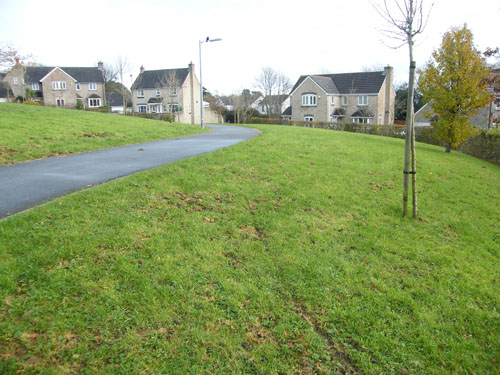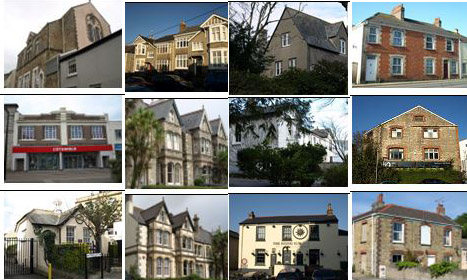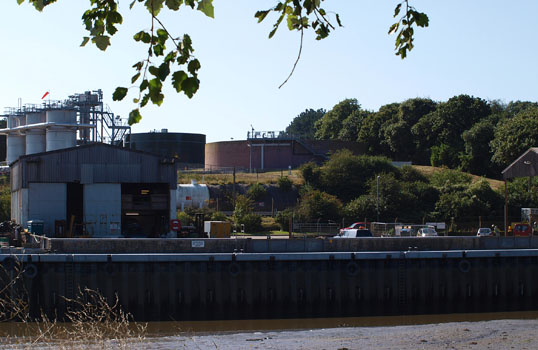Green Spaces and Land Use
A Personal View
By Michael Burgess.
Dr Mathew White and colleagues at the European Centre for Environment and Human Health at the University of Exeter Medical School based here in Truro have carried out some very interesting and detailed research on the effects on mental health of living in urban areas without good parks, gardens or other green spaces nearby. The study uses data from an 18 year panel survey of the psychological health of over 10 thousand individuals at different points in time. This was correlated for the individuals with the amount of green space nearby using a high resolution search of the Generalised Land Use Data base. The scientists examined the importance of any green space effect on psychological health. They corrected for such things as changes in employment, marital and health status for any individual. They found that there was a significant, measurable association between green space and wellbeing, especially for the poorest members of society.
Many people underestimate the impact that mental health conditions can have. The cost to individuals, their family and society is huge. One in four will experience some kind of mental health illness in their lives. The positive impact of living in an area with relatively high levels of green space is roughly a third of the impact of being married vs unmarried and a tenth of being employed vs unemployed. The cost of mental illness to the NHS is about 13% of a total budget of £108 billion per year. It is a Cinderella service, it is estimated that half the ill health of people under 65 is caused by mental illness. The total cost, including loss of earnings, associated treatment and welfare costs is a great burden. It works out for business at just over £1,000 per employee per year. Sick leave for mental illness alone is estimated to be £8.4 billion. If investment in green spaces can make a significant personal difference for individuals it would also make financial sense for society.
A recent Department of Health study highlights the increasing cost to society of obesity. This study produced a series of cost estimates for elevated Body Mass Index (BMI) to the NHS over the next few decades. The costs include not only the direct costs of treating obesity but also the many other conditions where obesity is a likely contributory factor. For example the risk of developing type 2 diabetes is at least 20 times greater for the obese compared to a lean person. Other heightened risks include coronary heart disease, strokes, many cancers and osteoarthritis. The direct additional cost to the NHS in 2015 is estimated to be £6.4 billion, more than the cost of treating illnesses caused by smoking or alcohol. Unless the growing obesity problem is tackled by all parts of society, the bill is expected to grow over the next few decades. The wider costs to families e.g. lost incomes, caring costs etc, would of course be much greater. To quote professor John Ashton, President of the Faculty of Public Health: “We need to have places where we live that support healthy living, so we do walk for some distance every day, make it easier to take exercise, to cycle, to eat healthily.” He lays a heavy responsibility on local authorities to reduce obesity, including the underlying causes rather than just their manifestation. This would require the provision of plenty of amenity land in the form of parks and play grounds.
A third area of current research and angst is intergenerational fairness, particularly in housing. “Housing wealth is slowly but surely becoming more concentrated in the hands of older households, and the number of older households with housing wealth is growing fast.” A quote from The Council of Mortgage Lenders. The main cause of unfairness is simply the systematic lack of building in the UK over the last 50 years. This leads to a shortage and ever increasing cost of housing, both to buy and to rent, which is hard on the young. This must increase stress levels for them and add to any mental health difficulties. “The worsening mental wellbeing of young people must be a policy priority” from a Times leader. Richard Harman, headmaster of Uppingham School has said that the mental health of his young people is his single largest concern.
All three areas of research are of course complex, there are many other factors: poverty, unsuitable diets, electronic games, social media, online pornography and overcrowding, to name just a few. However one theme that runs throughout is the lack of land for development. Land, with planning permission to build, costs many times its agricultural value and amenity land is likewise priced in a similar way. Existing settlements end up being opposed to new development as it is perceived to be harmful to their interests. We are trapped in a terrible cycle where we haven’t built enough, and the homes we have built are often too small and often unattractive, with tiny gardens. Because it is hard to get permission to build, developers either go for high value or they pack in as many cheaper houses as possible when they do get permission. Government land use statistics show new dwellings at a density of 43 per hectare. Allowing for the house/flat footprint and a car parking space that does not leave much room for a garden or open space. A significant percentage of recent building has been on brown field sites. This is a partial solution, but usually they too only provide small gardens. In recent times no way through the shortage of land conundrum has been found and some fresh thinking is necessary.
A distant view of Kenwyn church tower which is surrounded by mature trees is a lovely sight. We know that there are dozens of houses under that canopy but the greenery somehow softens the harsh outlines of the buildings. We should have a very firm policy to prevent developers removing mature trees and encourage them to plant plenty of new trees. According to the research, views over water, woodland or green fields can have a beneficial effect. It would be important to retain the remaining attractive views from the bowl of ancient Truro, e.g. the fields along Trennick Lane beyond Truro School and allow no further development on that ridge.
A more contentious idea is that extra land should be made available for housing and the density of the houses should be reduced. Normal economics should then reduce the price of plots in due course. It is self evident that once agricultural land is used for building, it is lost forever. Forty or fifty years ago most houses came with a decent sized garden, even council houses had room for a vegetable patch and grass on which children could play cricket or football. For understandable reasons modern policy has required a much greater density. This does come at a substantial cost to mental and physical health. Perhaps the time has come to review our almost instantaneous negative reaction to using more land for houses. We have to accept that we are largely an urban nation and may have to sacrifice a bit more farmland. This could improve the welfare of all our people. Not just for the fortunate minority that can afford nice houses with a proper garden, surrounded by trees. A good example is available on Google Earth; search for: “Taylor Wimpey The Manor House Estate” in Tavistock. Notice the difference between the expensive houses surrounded by trees and open lawns and the other side of the hedge line where the cheaper and social housing has been built. There are no trees and tightly packed houses, with only a small play area for the children.
Like it or not, the world population is expected to peak at about 10 billion this century: an increase of about 40%, before it stabilises. There may also be substantial population movements for economic or climate reasons. A percentage of these people will fetch up in Cornwall and Truro will be accepting its share. Away from the older parts of our city the new housing estates reflect the high density policy, with small gardens and not much green space. Whereas the city centre has an active Parks Department which provides for hanging baskets, flower beds, tended verges on the roads, planted roundabouts and lovely parks. West of County Hall there is little sign of this kind of investment. Yet most of the future growth of the city is planned for this area. Recently the county council has even been busy selling off existing amenity land. The future city may lose all its charm if the inevitable expansion is carried out without substantial effort to provide new attractive green spaces, suitable for all to play and exercise. To those who might say that investing in green spaces, parks and gardens would be too expensive the answer is that the alternative might cost even more. There are savings to be had from looking after the mental and physical health of our own people.
To achieve the benefits of a greener environment there has to be a delivery mechanism. It may not be possible to add to the existing planning obligations imposed on developers: The Community Infrastructural Levy or Section 106 agreements. We might need a new approach. Landowners obtaining planning permission are, in effect, given a valuable gift. As compensation to society, alongside permission for a given number of dwellings there could be a side agreement for a reasonable amount of amenity land handed over to the city at the prevailing agricultural price. This land could be turned into attractive gardens and play areas or parks that would surround the houses or flats. It would probably need to be adopted and maintained by an expanded Parks Department. The Civic Society has been a doughty defender of the planning boundaries of our city, to prevent urban sprawl. As the city expands the countryside will be moved further away from existing houses. It might be better, initially to take in greater amounts of countryside, that would allow some spare land to be turned over to these vital green spaces within walking distance of the housing estates, not external to the city. The countryside would have been brought into the town both to the benefit of the dwellers and local wildlife.
It is a pity to lose farmland. “There will always be those that fight to save England’s beauty”, to quote a recent campaign by CPRE, but beauty is not just in the countryside. Everybody needs beautiful places to live, even if its only an expanding suburb of Truro city. Over the past fifty years output from farms has increased at least three fold and farm worker productivity by about ten times. There is no reason for farm output not to continue to increase into the future. The nation imports nearly half the food we eat (48%), the biggest suppliers are the Netherlands, Spain, France, Irish Republic, Germany and Italy. These neighbours are near and have spare capacity, so perhaps worries about food security can be consigned to the history books. A small loss of agricultural land will not make much of a difference to farm output but could make a big difference to the health of future city dwellers.






